The OnePlus 3T Review
by Brandon Chester on November 28, 2016 10:30 AM EST- Posted in
- Smartphones
- OnePlus
- OnePlus 3T
Display
My original review of the OnePlus 3 was somewhat controversial for its display section. At the time it shipped, the OnePlus 3 was set to a fixed color mode that targeted the NTSC color gamut. NTSC in this case refers to the original specification for analog color television in the United States, rather than SMPTE C which was actually more commonly targeted at the time for real equipment due to NTSC coverage not being possible on the CRT displays of the time with an adequate luminance level.
The issue with shipping a gamut other than sRGB as the only color mode on an Android phone is that Android has no color management whatsoever. This means that there's no mechanism for the operating system and its associated frameworks to understand what color space content has been created for, and what color space is used by the actual display on the phone. This means that if the display uses a different gamut than sRGB, the colors in content that targets sRGB will not be properly converted to the display's color space so they can be displayed correctly. For example, if part of an image created in sRGB had component values of RGB (255,0,0) which would make it the most saturated red possible in sRGB, the display would render it as the most saturated red possible in its native color space. This would cause distortion unless the different gamut happened to also use the same CIE XYZ tristimulus value for red.
Regardless of whether your preference is for more saturated colors, or for color accuracy, I think everyone can agree that a device should be able to display colors accurately if the user wants it to. After my review, OnePlus issued an update to all OnePlus 3 units which added an sRGB color mode for accurate color rendering. You can read my follow up piece which went over these changes, but the end result is that the OnePlus 3 went from having one of the most inaccurate smartphone displays to having one with a high degree of accuracy.
The OnePlus 3T uses the same 5.5" 1920x1080 PenTile AMOLED display as the OnePlus 3. It also includes the newest version of OxygenOS, which has made it easier for users to access the different color modes available. While the sRGB mode was originally added to the hidden developer section of the settings app, it now has its own section right in the display settings, which is a great move on OnePlus's part. With how accurate the OnePlus 3's display was, one would hope that the OnePlus 3T will be as good, if not even better.
As always, I've run our standard display workflow on the OnePlus 3T, which examines attributes like peak brightness, greyscale accuracy, saturation accuracy, and color mixture accuracy. Data is collected using an X-Rite i1Pro 2 spectrophotometer and managed using SpectaCal's CalMAN 2016 software.
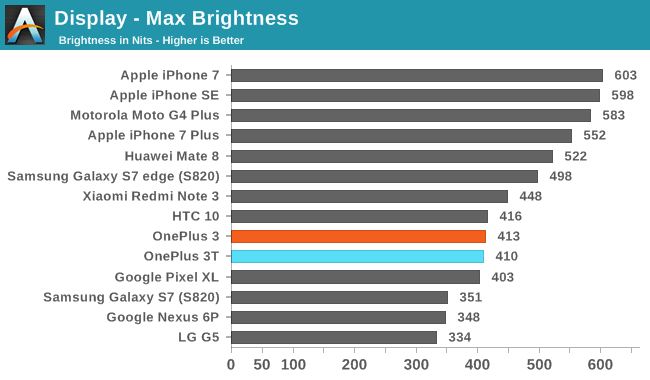
With the same panel in use, it's not surprising to see that the peak brightness level is essentially equivalent. Using an AMOLED panel means that blacks are almost perfect, leading to a near-infinite contrast ratio in an optimal setting. In practice there's obviously a degree of light from other sources which is reflected by the display, so you don't get a truly infinite contrast ratio, but the black levels are as close to perfect as one can possibly get.
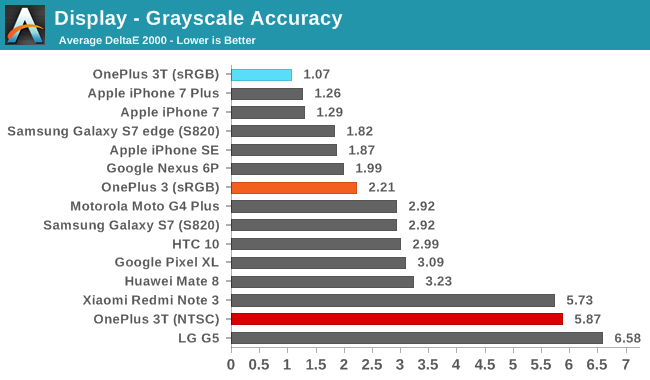
OnePlus 3T in NTSC mode (above) compared to sRGB mode (below)
As expected, the accuracy relative to sRGB is terrible in the default mode which targets the NTSC color gamut. Meanwhile, the sRGB mode is incredibly accurate, with many colors being essentially indistinguishable from the reference shade. The OnePlus 3 already exhibited great accuracy in its sRGB mode, so seeing it pushed even further is surprising. In this case, the gamma is closer to our target of 2.2 at each shade, and the RGB balance for each shade of grey is also more uniform than the OnePlus 3. It's really impossible to say whether this is true of all units. It could be that actually shipping the sRGB mode with the phone has allowed for dedicated calibration in that mode, or this could just be an exceptionally good sample. Either way, when you consider both this and the OnePlus 3's sRGB mode, it's a safe bet that you'll be able to get great accuracy for greyscale shades on OnePlus's latest phones.
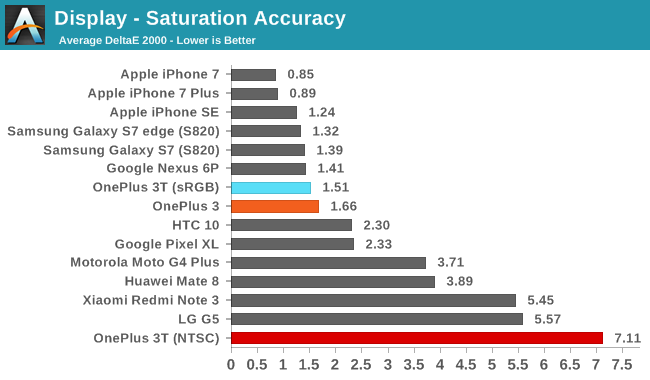
OnePlus 3T in NTSC mode (above) compared to sRGB mode (below)
Given that the original NTSC standard is wider than sRGB, the accuracy is quite poor in the default mode. Like the greyscale test, turning on the sRGB color mode enables a level of accuracy that few other smartphones can match. Technically you can see the difference between the colors if you place them directly beside some object showing the true reference shade, but realistically even creative professionals that need a high level of color accuracy would be thrilled by a display calibrated as well as the one on the OnePlus 3T.

OnePlus 3T in NTSC mode (above) compared to sRGB mode (below)
The GretagMacbeth ColorChecker test produces the same sort of result as the separate greyscale and saturation tests. This test effectively measures if both of those two tests produced good results, as to accurately render color mixtures you need to have an accurate gamma and white balance, as well as accurate primary and secondary color rendering. In the standard mode the accuracy is poor, and in the sRGB mode it's great.
As far as color accuracy goes, there's honestly nothing to complain about on the OnePlus 3T when you put it in its sRGB mode. I still disagree with the default mode being severely inaccurate and targeting a gamut that isn't used anywhere, but OnePlus has done a great job with making the settings accessible for users. They're no longer buried inside the hidden developer section of the settings app, and OnePlus has even highlighted it in their reviewers guide which indicates to me that they understand the value of giving users the choice of whatever color mode they'd like, including the option to have accurate colors for situations that demand it.
While the OnePlus 3's display is certainly outstanding as far as accuracy is concerned, I do feel that it's worth mentioning again how the sharpness of a 401ppi PenTile display is not the same as that of a 401ppi LCD display. As far as text rendering goes, the OnePlus 3 and 3T are clearly not as sharp as the OnePlus One and OnePlus 2. I would even say that text rendering is not as good as an RGB LCD in the 300-350ppi range, such as the ones Apple uses on the smaller iPhone models. This is the result of two factors, with the first being the lacking red and blue subpixels to be used in rendering what's on the screen, and the second being the actual subpixels themselves. The subpixel array is irregular due to the diamond-shaped groupings of subpixels, and the subpixels are not of a uniform shape or size either. This makes the pattern itself less suitable than an RGB display for rendering text, as you get irregular aliasing on the edges where the subpixels are not arranged in a straight line.
While I would love if OnePlus could ship a 1440p AMOLED display on the OnePlus 3T, such a panel would be too expensive to fit into the price point OnePlus is targeting. I suppose that my main disappointment is that even with the high level of accuracy on the OnePlus 3T's AMOLED display, if OnePlus were to ship the phone using the original LCD display from the OnePlus One tuned to this level of accuracy it would certainly be a better display overall. Peak brightness would be higher, text would be sharper, and you wouldn't have AMOLED's off-angle hue shift.
In the end, I still think the OnePlus 3 and 3T have very good displays, and they are greatly improved compared to the OnePlus One and OnePlus 2 in many ways. My only real complaint is that some areas have also regressed compared to the first two OnePlus phones. When you consider where OnePlus sits in the smartphone market as far as price and specs are concerned, you're still getting a great display for your money, and if you want a phone with a 5.5" 1440p AMOLED panel it's going to cost considerably more. As of right now I'm just skeptical that AMOLED is the right way to go for larger devices in the $400 range until we can get 1440p PenTile panels or 1080p RGB ones.


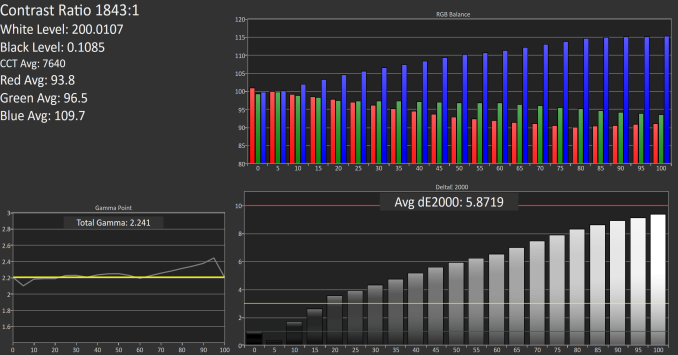
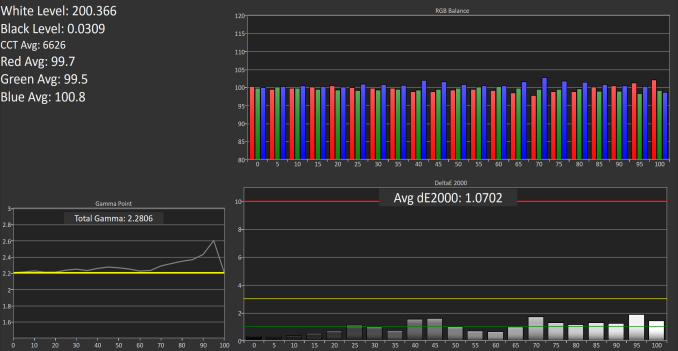
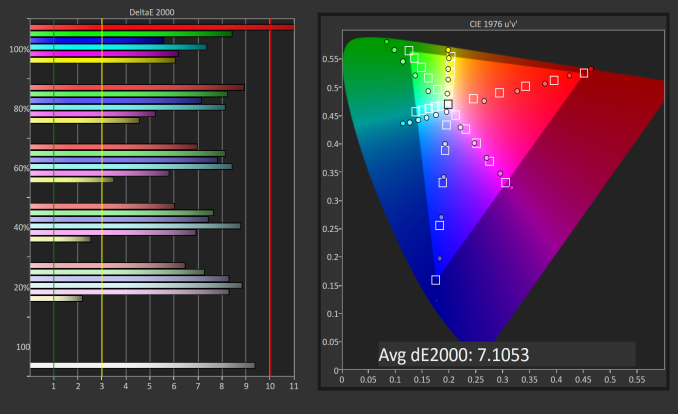


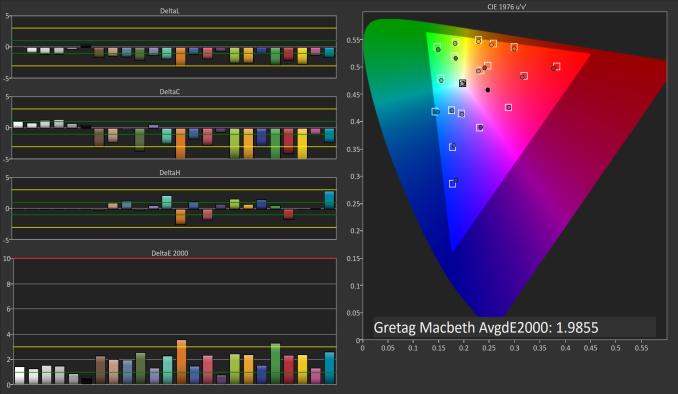








104 Comments
View All Comments
leexgx - Wednesday, January 18, 2017 - link
i just wish they keep most of the buttons near the top left and right side of the phone (some phones have the buttons to low so can use them in phone holder as it presses them)leexgx - Wednesday, January 18, 2017 - link
""can't use phone holder when are all on one side (power button right side, volume on left side is the preferable way, might not be ideal for left handed people but this is how they are norm setup)Pino - Monday, November 28, 2016 - link
ZTE Axon 7 for $ 349 on cyber Monday, with a free Bluetooth beats phone is a much better deal.JoeyJoJo123 - Monday, November 28, 2016 - link
I prefer having the ability to load the most common and popular open-source Android-based OS, Cyanogenmod. Cyanogenmod continues to issue updates to my (apparently ancient, despite only being 2 years old and still very functional) Nexus 4, which Google no longer provides updates for.ZTE Axon 7 has no Cyanogenmod support, and like many other Android phones, it will cease to have manufacturer support (planned obsolescence) after a year, if you're lucky.
I'm looking into a Oneplus 3T now, as Google no longer provides affordable Nexus phones, but mostly because my current Nexus 4 has a degraded battery life over 2 years of charge cycles. Despite lowering the brightness, barely using it, and blocking many applications, my Nexus 4 only tends to last me 12 hours of very light use, and sometimes it fails to last the work day, from when I remove the phone from the charger in the morning, by the time I get back home to charge it again. The upgraded 3400 mAh battery on the OnePlus 3T is a solid selling point, as I'm looking for better longevity of battery life 2 ~ 3 years down the line.
negusp - Monday, November 28, 2016 - link
The Axon 7 has a CM13 port, and everything seems to work so far.For the price the Axon is unbeatable.
And the Nexus 4 always had sh*t battery life. No way around it. Replacing the battery isn't too difficult either.
JoeyJoJo123 - Monday, November 28, 2016 - link
I'll have to concede, there does appear to be a port, but apparently you have to get it directly from XDA forums, and it's an unofficial port; it's not listed on the CyanogenMod website at all.http://forum.xda-developers.com/axon-7/development...
The following are the only official ZTE Cyanogenmod builds listed on Cyanogenmod's site:
https://download.cyanogenmod.org/
ZTE
Blade (blade)
Nubia Z9 Max (nx510j)
Skate (skate)
V9 (v9)
Meanwhile OnePlus's section includes every major phone they've released thus far, save for the 3T which was just released (and sure to get official support in the coming weeks).
OnePlus
2 (oneplus2)
3 (oneplus3)
One (bacon)
X (onyx)
Given ZTE's poor support record on CyanogenMod, I hope that changes for the better in the future. It's the poot CyanogenMod support for manufacturers like Xiaomi, Honor, and Huawei (and now ZTE) that prevent me from buying into the platform. When I buy a phone, a buy something sensibly priced and I intend for it to last me longer than even typical 2 year upgrade plans.
negusp - Monday, November 28, 2016 - link
Your last point is the most important. People who value a Nexus-like phone should get an Axon 7. In that way, we drive demand for ports and releases of custom ROMs.The 3T also won't get very much support, and hasn't been received kindly by the dev community. One of the most notable was flar2 who has said he won't be porting his elementalx kernel to it.
FlyBri - Monday, November 28, 2016 - link
It has already changed for the better ZTE has already confirmed it is working with Cyanogen mod as we speak, and so the Axon 7 is getting official CyanogenMod support. So while the ROM isn't out yet, one will be coming. Looks like your concern about poor support from ZTE regarding Cyangenmod has been eliminated.pierrot - Tuesday, November 29, 2016 - link
CM support official or not is a huge feature. It even makes that cheapo Amazon Fire halfway usablerealbabilu - Tuesday, November 29, 2016 - link
I disagree. CM support or Rom continuity always needed. Software bug , and security hole always there. There are not plenty mobile phone that keep it run long enough to patch every bug, as far i owned and experiences, those one with cm support like oneplus, those one with iOS, and those one with miui rom for Xiaomi phones, that updated regularly.And one thing others is availability hardware spare part, especially the battery and the screen replacement as those are fast moving sparepart for mobilephones. It can be replaced by third party repairman. iPhone always have a big numbers spare part availability on market, Xiaomi phones also have a lot. Oneplus not so many, ZTE even little.